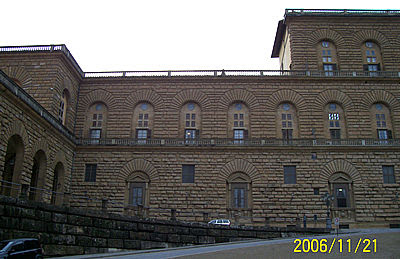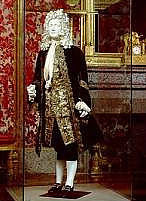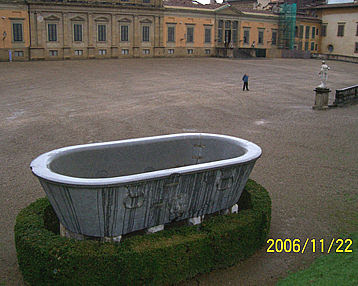On Tuesday 21 November 2006, after crossing over the river Arno along the Ponte Vecchio, we walked the short distance to the Palazzo Pitti (or Pitti Palace). The core of the present palace dates from 1458 and was originally the town residence of Luca Pitti, an ambitious Florentine banker. It was bought by the Medici family in 1539 as the official residence of the ruling families of the Grand Duchy of Tuscany.

In the 19th century, the palazzo, by then a great treasure house, was used as a power base by Napoleon, and later served for a brief period as the principal royal palace of the newly-united Italy. In the early 20th century, the palace and its contents was given to the Italian people by King Victor Emmanuel III. Subsequently its doors were opened to the public as one of Florence's largest art galleries.
The rusticated stonework gives the palace a severe and powerful atmosphere, reinforced by the three times repeated series of seven arch-headed apertures, reminiscent of a Roman aqueduct. This original design has withstood the test of time, and its influence has been maintained and continued during later additions to the palace.

When Cosimo de Medici moved into the palace, he had Vasari enlarge the structure to fit his tastes. The palace was more than doubled in size and Vasari also built the above-ground walkway from Cosimo's old palace, the Palazzo Vecchio, through the Uffizi, above the Ponte Vecchio to the Palazzo Pitti.
There are 140 rooms in the palace that are open to the public, some of them large halls so, to fit a realistic viewing experience into the time available, we decided to sample only four of the galleries.
Palatine Gallery
The Palatine Gallery contains a collection of over 500 principally Renaissance paintings, which were once part of the Medici’s and their successors' private art collection. The gallery, which overflows into the royal apartments, contains works by Raphael, Titian, Correggio, Rubens, and Pietro da Cortona. Also very impressive were the marble-topped tables dotted here and there in nearly every room. Marbles of different colours were inlaid, sometimes in the most intricate and delicate designs.
The rooms are richly decorated and have painted ceilings. We particularly enjoyed the room of Hercules where this strong man was depicted in various battles with centaurs, lions and so forth.
Royal Apartments
The Royal Apartments is a suite of 14 rooms, formerly used by the Medici family, and lived in by their successors. These rooms were last redecorated in the 19th century. They contain a collection of Medici portraits, many of them by the artist Giusto Sustermans.
In contrast to the great salons containing the Palatine collection, some of these rooms are much smaller and more intimate, and, while still grand and gilded, more suited to day to day living requirements. Period furnishings include four-poster beds and other necessary furnishings not found elsewhere in the palace. Each room is decorated in a different colour, with all the furnishings and drapes matching the main colour theme.
The Kings of Italy last used the Palazzo Pitti in the 1920s. By that time it had already been converted to a museum, but a suite of rooms (now the Gallery of Modern Art) was reserved for them when visiting Florence officially.

Silver Museum
The Silver Museum, sometimes called "The Medici Treasury", contains a collection of priceless silver, cameos, and works in semi-precious gemstones. These rooms, formerly part of the private royal apartments, are decorated with 17th-century frescoes, the most splendid being by Giovanni di San Giovanni. The Silver Museum also contains a fine collection of German gold and silver artefacts purchased by Grand Duke Ferdinand after his return from exile in 1815, following the French occupation.

Costume Gallery
This gallery contains a collection of theatrical costumes dating from the 16th century until the present. In addition to the theatrical costumes the gallery displays garments worn between the 18th century and the present day, giving a good impression of Italian fashions of that period.

This delightful fountain decorated with a plenitude of cherubs sits on a balcony at the back of the Pitti Palace.

This picture is a view of a portion of the Pitti Palace from the back of the building. We still don't know what the purpose is of this huge marble tub, but we guess it may have been intended as a planter. To give you an idea of the scale of this tub, look closely and you'll see Willem standing in the middle distance towards the building.

No comments:
Post a Comment